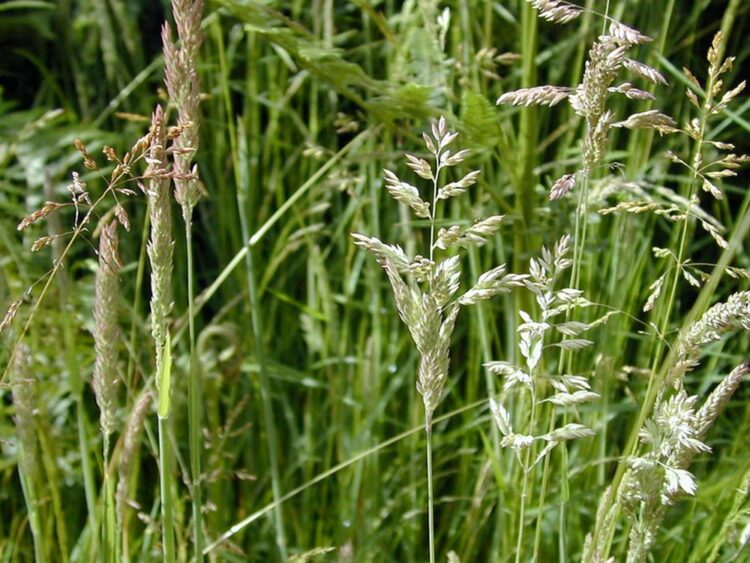How grasslands respond to climate change

Grasses on the Rothamsted Research experimental field.
Credit: Rothamsted Research
Effects of CO2 increase were already apparent in the past century.
“Based on field experiments with increased carbon dioxide concentration, artificial warming, and modified water supply, scientists understand quite well how future climate change will affect grassland vegetation. Such knowledge is largely missing for effects that already occurred in the last century,” says Hans Schnyder, Professor of Grassland at the TUM.
Based on the Park Grass Experiment at Rothamsted, researchers have now shown that future predicted effects of climate change on the nutrient status of grassland vegetation have already taken hold in the last century.
Plant intrinsic mechanisms respond to CO2 increase
Since 1856, research at Rothamsted has been testing the effects of different fertilizer applications on yield performance and botanical composition of hay meadows. Harvested material has been archived since the experiment began. This material is now available to researchers for studies of vegetation nutrient status, and the carbon and oxygen isotope composition of biomass.
“The increase in atmospheric CO2 concentration also affect the carbon, water, and nitrogen cycles in grasslands as well as other biomes,” says Professor Schnyder. The mechanism that controls gas exchange with ambient air (the stomatal conductance of the plant canopy) is a key player in these cycles.
Plants control how far their stomata, small pores in the leaf epidermis, open to optimize the balance between carbon dioxide uptake (photosynthesis) and water loss (transpiration). With increased CO2 exposure, they reduce stomatal aperture to save water. This effect is particularly efficient in grasses. However, a reduction in transpiration leads to a reduced mass flow from the soil to the roots and leaves, which can result in reduced nitrogen uptake and feed back to weaken photosynthetic capacity.
Yield reduction and deterioration of the nitrogen nutrition status
Combining the new analyses of oxygen and carbon isotope composition, nitrogen and phosphorus in biomass, and yield and climate data, the research team, led by Professor Schnyder, analyzed the physiological effects of the emission-related increase in CO2 concentration (about 30%) and associated past climate change.
They found that in particular the grass-rich communities that were heavily fertilized with nitrogen experienced a deterioration in their nitrogen nutrition status. Climate change also resulted in greatly reduced stomatal conductance (now detectable with the new research methods) and significantly reduced yields.
The core element of the researchers’ observations is the hypersensitive CO2 response of stomata in grasses which they believe limits transpiration-driven nitrogen uptake.
Nitrogen fertilization has no positive effects on grassland yield performance
“We also observed that fields that were heavily fertilized with nitrogen, and therefore rich in grass, largely lost their yield superiority over forbs- and legume-rich fields that were either less or completely unfertilized with nitrogen despite being otherwise equally supplied with nutrients over the course of the last century,” says the first author of the study Juan Baca Cabrera, who is pursuing a doctorate at the TUM’s chair of Grassland.
In the researchers’ view, the results indicate that restraining nitrogen supply to grasslands in the future would enhance the yield contribution from forbs and legumes while at the same time would help limit nitrogen emissions to the environment. Professor Schnyder states, “Our findings are important for understanding the importance of grasses in earth systems and provide guidance for sustainable future grassland use.”
All latest news from the category: Ecology, The Environment and Conservation
This complex theme deals primarily with interactions between organisms and the environmental factors that impact them, but to a greater extent between individual inanimate environmental factors.
innovations-report offers informative reports and articles on topics such as climate protection, landscape conservation, ecological systems, wildlife and nature parks and ecosystem efficiency and balance.
Newest articles

Parallel Paths: Understanding Malaria Resistance in Chimpanzees and Humans
The closest relatives of humans adapt genetically to habitats and infections Survival of the Fittest: Genetic Adaptations Uncovered in Chimpanzees Görlitz, 10.01.2025. Chimpanzees have genetic adaptations that help them survive…

You are What You Eat—Stanford Study Links Fiber to Anti-Cancer Gene Modulation
The Fiber Gap: A Growing Concern in American Diets Fiber is well known to be an important part of a healthy diet, yet less than 10% of Americans eat the minimum recommended…

Trust Your Gut—RNA-Protein Discovery for Better Immunity
HIRI researchers uncover control mechanisms of polysaccharide utilization in Bacteroides thetaiotaomicron. Researchers at the Helmholtz Institute for RNA-based Infection Research (HIRI) and the Julius-Maximilians-Universität (JMU) in Würzburg have identified a…



